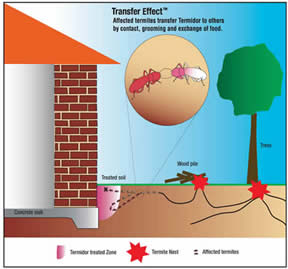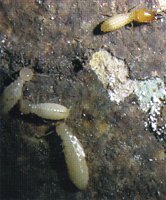There are many questions that come up regularly from our clients, so, in order to put your mind at ease, we have assembled answers to the most common questions below. If your question is not answered, feel free to click here and contact us.
Q:What is the difference between White Ants and Termites?
A: They are the same insect.
Q: Why does the same insect have two different names?
A: The early settlers to Australia came mainly from England and Ireland, where there are ants, but no termites. When they found insects that looked like ants, but lighter in colour, destroying the timbers in their houses, they referred to them as White Ants and this was the common name in Australia for many years.
In America and the Pacific Islands they are known as Termites. Gradually, as Australia has become more and more influenced by American companies and products, the use of Termites has taken hold and is the recognised correct name for these insects worldwide.
Q: Are there different types of termites?
A: There are different types of Termites and those that cause so much damage in South Australia are Subterranean Termites, which live and forage underground from where they can come up into your house from under the wooden or concrete floors to infest the timber above.

Q: What is a Termite Barrier Treatment?
A: A Barrier Treatment is the application of a liquid Termiticide to the soil beneath the floors and footings of the house to both deter and kill Termites when they attempt to pass through it to gain access to timbers above. In many instances this barrier is also applied around the external perimeter of the footings as well, depending on type of construction.
Q: What is a Termite Baiting System?
A: There are two different types - Monitored and Soil Injected.
Monitored Systems comprise of round plastic containers called monitoring bait stations and placed at intervals, usually about three metres apart and about 300mm deep in the soil around the external perimeter of the building. These stations contain strips of wood chosen as being attractive to White Ants/Termites and have a removable lid at surface level to allow for regular inspection of the wood to determine whether or not foraging termites have found it.
 If and when Termites become active within the station a slow acting bait is introduced. This bait is unknowingly carried back by the worker Termites to the main colony and if enough bait reaches the colony it will die out.
If and when Termites become active within the station a slow acting bait is introduced. This bait is unknowingly carried back by the worker Termites to the main colony and if enough bait reaches the colony it will die out.
Inside the building where Termites can be found active, for example in a timber frame wall, the same bait material is also introduced to their galleries, either directly or through another type of bait station.
They require regular and careful monitoring at varying intervals, usually about six weeks apart, to be successful. It is important the monitoring/bait stations in the ground do not become full of water or taken over by other insects, which quite frequently occurs.
Soil Injected Systems are designed to take advantage of the unique properties of Fipronil, which is the active Termiticide in the product Fipforce. The soil adjacent to the building footings is treated by either injection or trenching right around the external perimeter. Termites foraging underground seeking entrance points to the building are not repelled by the Fipronil and upon entering the treated soil become contaminated, both through ingestion and contact.
Termites which enter deep into the treated soil and pick up a high dose of Fipronil will die fairly quickly. Those which don't enter deep will pick up a low dose and survive for some time, long enough in fact to transfer Fipronil to other uncontaminated Termites by contact, grooming and exchange of food. The transfer then "Cascades" in a similar manner to still more members of the termite colony and large numbers die. As with all baiting systems, if enough of the active Termiticide reaches the colony it dies out.
The Soil Injected System does not need to be monitored as "The Bait" is there in the soil waiting for the termites year round, not added only after Termites are located in monitoring stations.
As the treated soil is continuous right around the building there is less chance the Termites can find a way in without becoming contaminated. With the Monitored Systems which depend on stations placed metres apart. The Termites can pass quite undetected between the stations.
Q: What is the best system - Termite Barrier or Baiting?
A: It depends very much on the construction of the building you are trying to protect. If it is practical to do so, as it is with most homes, the barrier system is the best choice, as it gives immediate control of an existing infestation and guards against re-infestation continuously and depending on the Termiticide chosen, can last between seven and ten years.
The Barrier System is nearly always the least costly, particularly over a period of years, as once per year maintenance inspection is usually adequate, while baiting systems can require a number of inspections per year, depending on the type used.
On the other hand, there are some buildings where, due to the type of construction, it is simply not practical to apply a Barrier System and if this is the case a baiting system may be the best choice.
With all systems regular and thorough inspection of the whole of the buildings and grounds is essential to ensure Termites have not found a weakness in the barrier or a way past a Baiting System.
Your Lawlor's Technician in preparing a treatment recommendation and quotation will take all factors into consideration and give you honest advice as to the most suitable system for your property.
From years of experience with many different types of buildings we have found the best protection and most cost-effective treatment we can supply is the Barrier Treatment, but often with a few monitoring/bait stations in the ground outside also, which we can check on annual inspections to determine what activity there may be outside the building. We have found this approach of combining the best of both systems provides you with maximum protection at the most reasonable cost.
Q: I have been told that spraying under my house is dangerous to my family's health - is this correct?
A: No, there is no danger to health or the environment. The Termiticides are water-borne and lock tightly to the soil beneath floors and footings.
 The great majority of Australian homes, offices, factories, schools, hospitals etc already have a Termiticide barrier applied beneath them and in our 80 years of Pest Control we know of not even one instance where an occupant has suffered harm as a result.
The great majority of Australian homes, offices, factories, schools, hospitals etc already have a Termiticide barrier applied beneath them and in our 80 years of Pest Control we know of not even one instance where an occupant has suffered harm as a result.
All of the products we use are extensively tested over many years and proven safe before they are given Government Registration and Approval for use.
The currently registered Termiticides used to create a barrier in the soil are Biforce, Fipforce, Biflex Ultra Lo, Termidor and Premise. They are all proven effective in protecting against infestation but act on the pests in different ways. The choice of which product to use to best suit a particular building and circumstance can be left to your qualified Lawlor Advisor with confidence.
